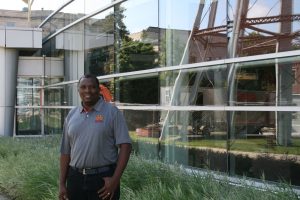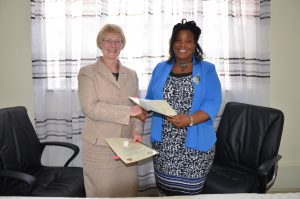
Martin Thuo is an assistant professor in the materials science and engineering department. He received his undergraduate and master’s degrees from Kenyatta University in chemistry and mathematics. In this guest blog post, he talks about a new collaborative opportunity between Iowa State and students and faculty in Kenya.
After moving to the United States, I realized how much I had available to me that I didn’t have in Africa. That’s not to say we didn’t accomplish a lot with what we did have, we just worked differently than we do in the U.S.; we had to think and develop solutions to local and global problems from a different perspective. With the College of Engineering at Iowa State and the school of engineering at Kenyatta University now joining hands in a partnership program, those different points of view will be one of the many things, I think, that will make the program a success.

Dean Sarah Rajala, Prof. Mufit Akinc (MSE), Prof. Ashraf Bastowros (AE), and I (MSE) recently visited Kenyatta University, which is located in Kenya (East Africa). During our time there, Dean Rajala and Prof. Olive Mugenda, Kenyatta University president, signed a memorandum of understanding that sets the stage for institutional collaboration and opens the door for members from either institutions to start reaching out to each other. This activity will eventually allow for both universities to develop a strong memorandum of agreement that will detail specifics of what exchange programs will be put into place.
Engineering at Kenyatta University is a relatively new program even though engineering related research and teaching has been going on for a while. As an alumnus of the university, I know collaboration opportunities are vast. I am excited about helping the program grow, particularly through improving instruction at Kenyatta while giving students at ISU a new, ‘limited-resource (frugal) mindset’ approach to problem solving. For example, at the end of each semester, students at Iowa State can donate their engineering textbooks to Kenyatta University, as engineering students in Africa typically do not even have the opportunity to purchase textbooks nor do most have the means to do so even if they had the books available. For the faculty, with most academic materials going digital, this collaboration can allow our faculty to impact the quality of engineers coming out of Kenya by donating their hard copies.
I also see future collaborations between the two universities to discuss current classwork and how to work through engineering problems and projects. Students will eventually have the opportunity to travel to Kenyatta University and be introduced to another country and vice versa. Because the president of Kenyatta University is an Iowa State alumna, many structures and viewpoints on campus mirror Iowa State from the campanile to the architectural design. There are also a good number of ISU alumni in the faculty pool, especially in the basics sciences, thanks to a previous collaboration between Kenyatta and ISU in training the university’s math and chemistry faculty. Students and faculty from both universities will feel at home wherever they are.
For the faculty members, research collaborations will be important. Though funding at Iowa State allows faculty to purchase advanced technology, faculty at Kenyatta University have learned to perform research with limited funds and technology. I believe there is a great opportunity for faculty at both universities to learn about building research projects using different approaches. New research funding may also become available as a result of the new collaboration, especially with various non-governmental funding agencies requiring some involvement of faculty from the developing world. Besides joint grants, exposure of our faculty to engineering challenges in a fast changing environment can also allow us to develop solutions to challenges in the U.S. with new insights and unique perspectives.
Most importantly, I believe student and faculty collaborations will create a new way of thinking for everyone involved. That global perspective is important for the future of engineering teaching and research, and I can’t wait to see this program evolve into something truly great!